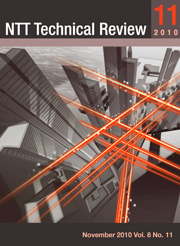
You need Adobe Reader 7.0 or later in order to read PDF files on this site.
If Adobe Reader is not installed on your computer, click the button below and go to the download site.

|
November 2010 Vol. 8 No. 11 |
|

View from the Top
 Fuminori Kozono, Senior Executive Vice President, NTT EAST Fuminori Kozono, Senior Executive Vice President, NTT EAST

Contributing to Regional Vitalization—
Entering an Era of HIKARI and NGN Services
Overview
At NTT EAST, the number of subscribers to its FTTH (fiber to the home) service called FLET”ĒS HIKARI (optical fiber broadband service) has topped 8 million and customer acceptance of broadband services that are fast and comfortable seems to be expanding rapidly. Considering this background, we asked Fuminori Kozono, Senior Executive Vice President of NTT EAST, to tell us how the company intends to incorporate HIKARI and NGN (Next Generation Network) services in its forward-looking strategies.
Special Feature: Cutting-edge Technologies for Seeing and Showing
 ICT Breakthroughs Driven by Scientific Insights into Human Cognition and Information Processing ICT Breakthroughs Driven by Scientific Insights into Human Cognition and Information Processing

Abstract
The mission of NTT Communication Science Laboratories (NTT-CSL) is to enable new methods of communication driven by fresh insights into human cognition and information processing. Our research projects encompass both human science and information science. This feature highlights recent NTT-CSL research on technology for seeing and technology for showing.
 High-resolution Multiband Imaging for Accurate Color Reproduction High-resolution Multiband Imaging for Accurate Color Reproduction

Abstract
Multiband imaging technology for highly accurate color reproduction has been developed by NTT Communication Science Laboratories. In this article, we describe the principle of our image-capturing and color reproduction techniques using multiband images. In a recent project, our systems generated images containing over 100 megapixels (maximum: 2 gigapixels) for cultural-heritage digital archiving. We also present recent research results for a multiband moving-picture system.
 Media Scene Learning: A Novel Framework for Automatically Extracting Meaningful Parts from Audio and Video Signals Media Scene Learning: A Novel Framework for Automatically Extracting Meaningful Parts from Audio and Video Signals

Abstract
We describe a novel framework called Media Scene Learning (MSL) for automatically extracting key components such as the sound of a single instrument from a given audio signal or a target object from a given video signal. In particular, we introduce two key methods: 1) the Composite Auto-Regressive System (CARS) for decomposing audio signals into several sound components on the basis of a generative model of sounds and 2) Saliency-Based Image Learning (SBIL) for extracting object-like regions from a given video signal on the basis of the characteristics of the human visual system.
 Topigraphy Project Topigraphy Project

Abstract
This article introduces topigraphy, which is a novel method for displaying a large-scale tag cloud as a contour map of related tags. It uses a topographic image as a background picture on which the tag cloud is displayed. The Topigraphy project is supported two weblog (blog) navigation systems: BLOGRANGER TG and BLOGRANGER QA. We have also developed a three-dimensional visualization system and applications for smartphones using the Android operating system (Android OS).
 Change Signals Provide Clues to Perception Mechanisms––Visual Illusions Reveal the Brain’s Information Selection Strategy Change Signals Provide Clues to Perception Mechanisms––Visual Illusions Reveal the Brain’s Information Selection Strategy

Abstract
Although the brain processes the immense amount of information contained in an image, what we consciously see is only a small part of the processed information. A new illusion that we have discovered shows that the change signals contained in images hold the key to the conscious visual experience.
 Computer Programming Education Using the Visual Programming Language Viscuit Computer Programming Education Using the Visual Programming Language Viscuit

Abstract
This article introduces the visual programming language called Viscuit, describes how it is used in practice to promote computer programming education, and explains why programming education is necessary.
Regular Papers
 Reliable and Efficient Photonic Network Architecture Based on a Hierarchical Hypercube Network Topology Reliable and Efficient Photonic Network Architecture Based on a Hierarchical Hypercube Network Topology

Abstract
This paper describes a novel photonic network architecture based on a hierarchical hypercube network topology and multi-degree reconfigurable optical add-drop multiplexers as the network nodes. The combination of hypercube topology and optical cross-connect functionality offers many attractive features, such as large capacity, scalability, flexibility, robustness, and low cost, which make it suitable for future metropolitan area networks. The architecture achieves robustness by utilizing the hypercube’s unique characteristic that an n-dimensional hypercube possesses n disjoint paths between arbitrary node pairs. An evaluation of network link capacity requirements showed that this network does not require as much link capacity as the conventional ring network and its required link capacity does not change with network scale. These results prove the effectiveness of this architecture.
Letters
 Advanced Wireless IP Access System (Advanced WIPAS) Compatible with FTTH Advanced Wireless IP Access System (Advanced WIPAS) Compatible with FTTH

Abstract
This article introduces the system concept, specifications, and some measurement results for the Advanced Wireless IP Access System (Advanced WIPAS) compatible with fiber to the home (FTTH), for which a prototype was developed in March 2010 (IP: Internet protocol). A wireless terminal prototype aimed at commercial use has been completed. Advanced WIPAS is a fixed wireless access system that can provide triple-play services, i.e., high-speed Internet access services, voice-over-IP (VoIP) services, and multicast high-definition television (HDTV) video transmission services. The system will help overcome the digital divide.
Global Standardization Activities
 Trends in Home ICT Standardization Trends in Home ICT Standardization

Abstract
With home information and communications technology (Home ICT) services expected to become popular in the near future, we describe trends in the standardization of the platform and other technologies that will lead to the remote maintenance services needed for implementing Home ICT services.
External Awards/Papers Published in Technical Journals and Conferences Proceedings
|

